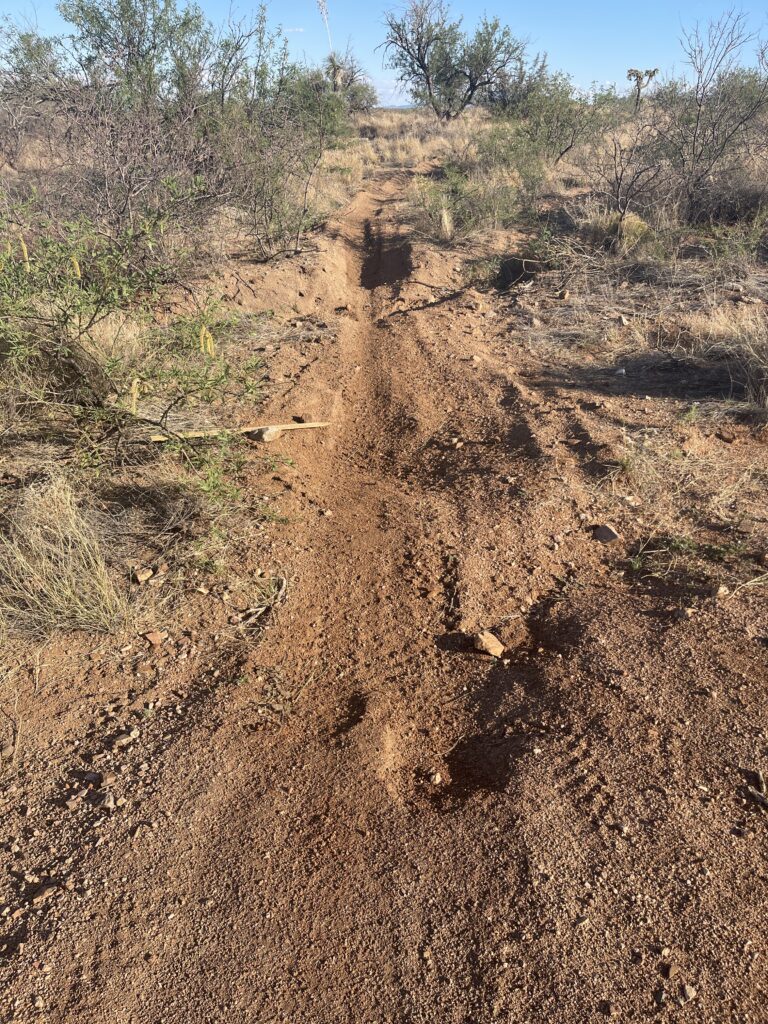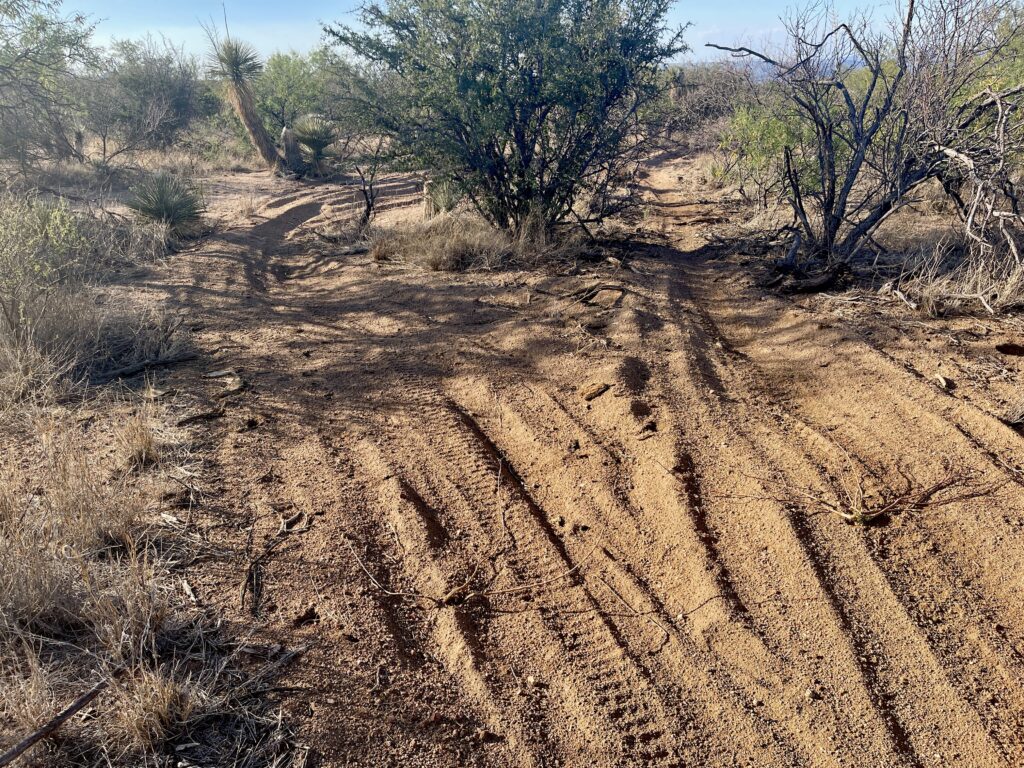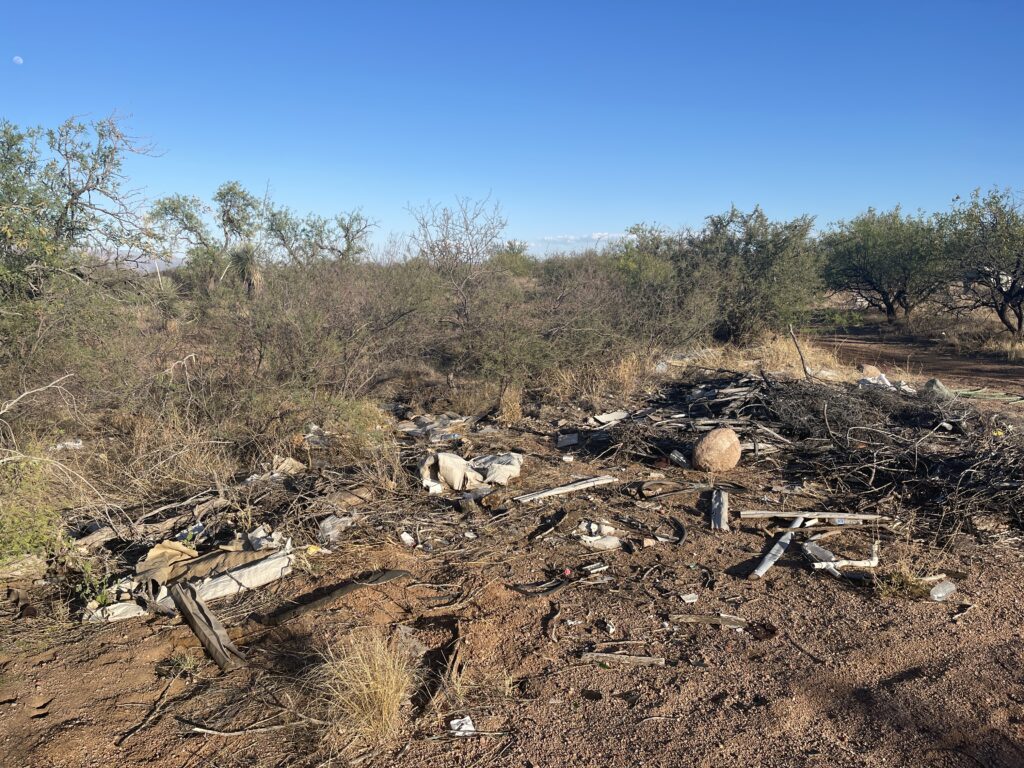
Single-track areas are evident in the area around San Manuel. Ruts and divots could be reduced if erosion control techniques are used after races. Photo by T.C. Brown
The San Manuel Copper Classic off-road motorcycle race is held annually at San Manuel, Arizona. The race is hosted by Trail Riders of Southern Arizona (TRS) typically in March. This annual event has both mini and big bike races. The event is promoted by the Arizona Motorcycle Riders Association (AMRA) and is an American Motorcyclist Association (AMA) sanctioned event. The next event is tentatively scheduled for March 7, 2026. This next year will be the 20th running of the race.
There has been some residents of San Manuel and the surrounding area expressing concerns about the damage to the desert caused in part by the annual race. The last few years have been held on BHP property due to permit cost and other concerns. The staging area and camping area have been, for several years, at the old Gardner Middle School property owned by the Mammoth-San Manuel Unified School District (MSMUSD).
Local members of TRS are the ones who lay out the track design. A larger group of TRS members come out prior to the event to place markers and get the track ready for racing. They do support local businesses when they are in town. Race attendees can support the local businesses as well on the weekend of the race.
TRS donates annually to local causes such as Community Schools and the San Manuel Fire District after holding this event. Local groups such as FFA and Little League have used the event to raise funds for their groups.
TRS provided the following information. “Trail Riders of Southern Arizona is a 501(c) 3 charity. As such after this year’s Copper Classic, profit from the revenue generated was given back to the community. TRS donated $5,000 to the Community Schools and $2,000 to the San Manuel Fire Department in April. The total donations over the 18 years of hosting the Copper Classic are approximately $45,000. Local groups such as FFA and Little league have used the event to raise funds for their groups.
“TRS is seriously interested in being a respectful and welcomed guest in the town of San Manuel. They wish to act as good stewards of the desert environment surrounding the San Manuel community. TRS would welcome an in-person meeting, perhaps in the San Manuel Community Center, with all concerned parties to discuss this issue in detail.”

Ruts and divots remain on the single-track areas used in March for the 2025 Copper Classic. It appears that they have also been used since race day. Photo by T.C. Brown
Not all damage comes from motorcycles or racers. The damage can also be attributed to others out in offroad vehicles and more. Some offroad enthusiasts are using cell phone apps that highlight trails around San Manuel. There is no doubt that this event is one of the reasons many people come to this area. The same can be said for outdoor enthusiasts who enjoy spending time in the desert around us. This is not intended to stop the use of the desert around us. It is believed that all sides can see improvement with some effort and involvement.
Many of the concerns mentioned have to do with the “Leave No Trace” philosophy. Here are some examples that might be applied with having a desert race.
- Leave No Trace Principles:
Plan Ahead:
Before the race, research the area, understand any restrictions, and make sure you have the necessary permits.
Pack It In, Pack It Out:
Carry all trash, including food packaging, empty water bottles, and any other debris.
Stay on Designated Trails:
Avoid creating new tracks or riding off-trail, as this can damage vegetation and disturb wildlife.
Minimize Campfire Impact:
If you have a campfire, use an existing fire ring, and ensure it’s extinguished completely before leaving.
Respect Wildlife:
Be aware of the animals in the area and maintain a safe distance to avoid disturbing them.
Clean Up After Yourself:
If your bike gets stuck or causes damage, take the time to clean up and repair any damage to the area.
- Responsible Vehicle Use:
Maintain Your Vehicle:
Ensure your bike is in good working order before and after the race to prevent breakdowns and minimize environmental impact.
Avoid Excessive Dust:
Riding at a slower pace in dusty conditions can help minimize dust kicked up by your vehicle, which can affect air quality and visibility.
Be Mindful of Sensitive Areas:
Avoid riding in areas with fragile vegetation or unique geological formations.
Proper Disposal of Waste:
Never bury waste, as it can contaminate the soil. Dispose of waste properly according to local regulations.
- Post-Race Cleanup and Restoration:
Repair Damage:
If you cause any damage to the area, make an effort to repair it or report it to the appropriate authorities.
Plant Native Vegetation:
If possible, help replant native vegetation in areas that have been disturbed to restore the ecosystem.
Support Local Conservation Efforts:
Contribute to local conservation organizations that work to protect the desert environment.”
Not all these examples are applicable in the case of the annual Copper Classic Race. Some would argue that this would depend on the agreements between TRS, MSMUSD and BHP since most of the event is held on private or school property. There are others that would say that the desert around San Manuel is a concern for all who live here, and they do not want the area to look like a big offroad track with no natural desert left. It seems that a civil discussion might help clear up some of the concerns and find common ground. Community involvement on race day and with track clean-up are viable options to strengthening this event and the relationship with TRS.
Input was sought from BHP and MSMUSD Community Schools. No response was received at the time of printing.

Not all damage is from motorcycles or other off-road vehicles. Some folks unfortunately use the desert as a place to dump their trash and debris. Photo by T.C. Brown
AI Chatbot Grok was used to summarize some of the key points referenced to understand different perspectives. It was quite interesting to search on the topic of ‘care for desert trails after a desert motorcycle race’, focusing on environmental stewardship, trail maintenance, or restoration to mitigate the impact of off-road racing. Desert ecosystems are fragile, and races like the Baja 1000, Dakar Rally, or local desert enduros can stress trails through soil erosion, vegetation damage, and litter. Below is a concise guide on how to care for desert trails post-race, based on best practices for environmental conservation and trail management.
Why Care for Desert Trails Post-Race?
-” Fragile Ecosystems”: Deserts have slow-growing vegetation and delicate soil structures (e.g., cryptobiotic crusts) that take years to recover from damage.
– “Erosion Risk”: Motorcycle tires can loosen soil, increasing wind and water erosion, especially in sandy or rocky terrain.
– “Wildlife Impact”: Trails may disrupt habitats for species like desert tortoises or bighorn sheep.
– “Sustainability”: Proper care ensures trails remain usable for future races and recreation while maintaining community support and land-use permits.
Steps to Care for Desert Trails After a Motorcycle Race
- “Clean Up Debris”:
– “Remove Litter”: Collect all trash from racers, spectators, and pit crews, including plastic bottles, food wrappers, and equipment scraps. Use volunteer cleanup crews if necessary.
– “Check Pit Areas”: Ensure fuel cans, tires, and other race materials are removed. Spilled fuel can harm soil and plants.
– “Signage Removal”: Take down temporary race markers, flagging tape, or signs to prevent wildlife entanglement or visual pollution.
- “Assess and Repair Trail Damage”:
– “Inspect Trails”: Survey the racecourse for ruts, widened trails, or damaged vegetation. Heavy bike traffic can create deep grooves or destroy plants.
– “Fill Ruts”: Use shovels or rakes to smooth out ruts and restore natural contours, reducing erosion risks. Compact loose soil where possible.
– “Avoid Overuse Areas”: If certain sections are heavily damaged, consider rerouting future races to allow recovery.
– “Protect Cryptobiotic Soil”: In deserts like the Mojave, avoid disturbing crusty soil layers (cryptobiotic crusts), which prevent erosion and support plant life. If damaged, consult land managers for restoration guidance.
- “Restore Vegetation”:
– “Replant Native Species”: If plants were uprooted, work with local conservation groups to replant native species like creosote or Joshua trees. Use seeds or seedlings suited to the region.
– “Limit Further Damage”: Fence off or mark sensitive areas to prevent post-race recreational use until vegetation recovers.
– “Watering (If Feasible)”: In some cases, limited watering of replanted areas can aid recovery, but follow local guidelines to avoid disrupting natural water cycles.
- “Control Erosion”:
– “Stabilize Soil”: Place natural barriers like rocks or fallen branches in eroded areas to slow water runoff and trap sediment.
– “Avoid Wet Conditions”: If rain is expected, delay trail use to prevent further damage to softened soil.
– “Consult Experts”: Work with land management agencies (e.g., BLM in the U.S.) to implement erosion control measures like check dams or contour trenching.
- “Engage the Community”:
– “Organize Cleanups”: Partner with local off-road clubs, race organizers, or environmental groups for post-race trail cleanups. Events like the Desert 100 often involve community restoration efforts.
– “Educate Racers” Promote “leave no trace” principles during pre-race briefings, emphasizing respect for the desert environment.
– “Report Issues”: Inform land managers about significant damage (e.g., illegal trail cutting) for professional restoration.
- “Plan for Future Races”:
– “Rotate Routes”: Avoid using the same trails every year to give ecosystems time to recover. Rotate courses or use established trails to minimize new damage.
– “Permits and Guidelines”: Ensure race organizers follow environmental regulations and obtain permits from agencies like the Bureau of Land Management (BLM) or equivalent.
– “Monitor Impact”: Conduct post-race environmental assessments to track long-term trail health and adjust race practices accordingly.
Practical Tips
– “Timing”: Start cleanup and restoration immediately after the race to prevent further degradation from weather or unauthorized riders.
– “Tools”: Bring rakes, shovels, gloves, and trash bags for cleanup. Use GPS or maps to mark damaged areas for follow-up.
– “Collaboration”: Work with organizations like Tread Lightly, the BlueRibbon Coalition, or local land trusts for expertise and resources.
– “Documentation”: Take before-and-after photos to track restoration progress and demonstrate commitment to land stewardship.
Challenges and Considerations
– “Scale of Damage”: Large races like the Baja 1000 cover vast areas, making comprehensive restoration challenging. Prioritize high-impact zones like pit stops or spectator areas.
– “Limited Resources”: Volunteer labor and funding may be scarce. Seek sponsorships or grants from off-road brands or environmental programs.
– “Balancing Use and Conservation”: Off-road racing faces scrutiny from environmentalists. Proactive trail care can maintain access to public lands by showing responsible use.
– “*Desert-Specific Issues”: Recovery in deserts is slow due to low rainfall and sparse vegetation. Even minor damage can persist for decades, so prevention is key.
Example from Practice
– “Baja 1000”: Organizers work with Mexican authorities and local groups to clean race routes, remove debris, and repair trails. Volunteers focus on sensitive areas like Baja’s Vizcaíno Biosphere Reserve.
– “Desert 100”: In Washington’s desert, the Stump jumpers Motorcycle Club organizes post-race cleanups, removing trash and smoothing trails to maintain good relations with landowners.
– “Dakar Rally”: In Saudi Arabia, organizers follow environmental protocols, including debris removal and route assessments, to protect desert ecosystems.
Resources
– “Tread Lightly”: Offers guidelines for responsible off-roading and trail restoration (treadlightly.org).
– “BLM (U.S.)”: Provides permits and restoration advice for races on public lands (blm.gov).
– “Local Off-Road Clubs”: Connect with groups like the AMA or regional motorcycle clubs for volunteer support.”
Caring for desert trails after a motorcycle race involves cleaning up debris, repairing trail damage, restoring vegetation, controlling erosion, and planning sustainably for future events. By collaborating with communities, following environmental guidelines, and prioritizing restoration, racers and organizers can minimize their impact and preserve desert trails for years to come.”
